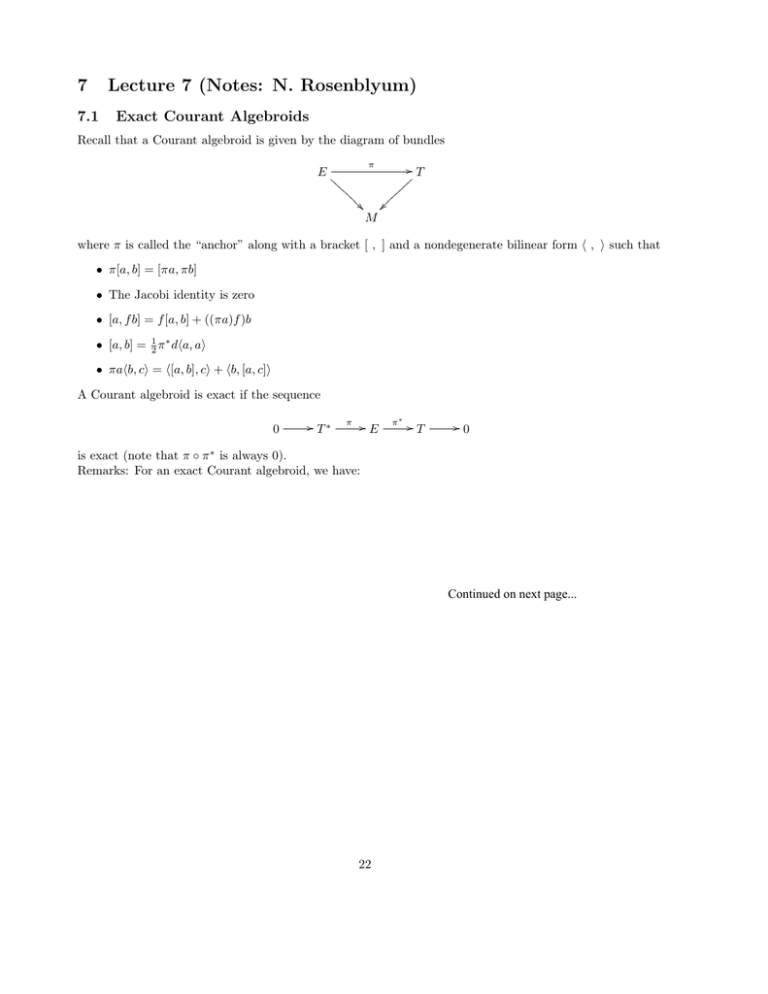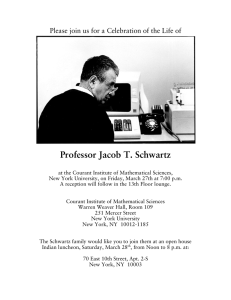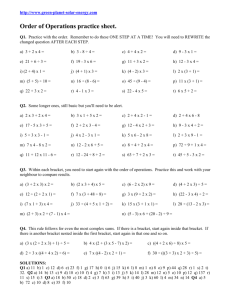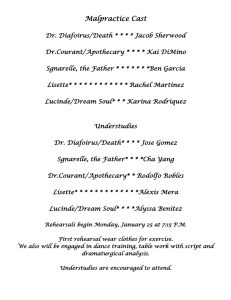7 Lecture 7 (Notes: N. ... 7.1 Exact Courant Algebroids
advertisement

7
Lecture 7 (Notes: N. Rosenblyum)
7.1
Exact Courant Algebroids
Recall that a Courant algebroid is given by the diagram of bundles
E�
��
��
��
��
π
M
�T
�
�
��
��
�� �
where π is called the “anchor” along with a bracket [ , ] and a nondegenerate bilinear form � , � such that
• π[a, b] = [πa, πb]
• The Jacobi identity is zero
• [a, f b] = f [a, b] + ((πa)f )b
• [a, b] = 12 π ∗ d�a, a�
• πa�b, c� = �[a, b], c� + �b, [a, c]�
A Courant algebroid is exact if the sequence
0
� T∗
�E
π
π∗
�T
�0
is exact (note that π ◦ π ∗ is always 0).
Remarks: For an exact Courant algebroid, we have:
Continued on next page...
22
1. The inclusion T ∗ ⊂ E is automatically isotropic because for ξ, η ∈ T ∗ ,
�π ∗ ξ, π ∗ η� = ξ(π ∗ πη) = 0
since �π ∗ ξ, a� = ξ(πa).
2. The bracket [ , ]|T ∗ = 0: for s, t ∈ C ∞ (E), f ∈ C ∞ (M ),
D = π ∗ d : C ∞ (M ) → C ∞ (E)
Now,
�[s, Df ], t� = πs�Df, t� − �Df, [s, t]� = πs(πt(f )) − π[s, t](f ) = πt(πs(f )) = �D�Df, s�, f �
Thus, [s, Df ] = D�s, Df �. We also have, [Df, s] + [s, Df ] = D�Df, s� and therefore [Df, s] = 0.
We need to show that [f dxi , gdxj ] = 0. But have [dxi , dxj ] = 0 and
[a, f b] = f [a, b] + ((πa)f )b, [ga, b] = g[a, b] − ((πb)g)a + 2�a, b�dg.
7.2
ˇ
Severa’s
Classification of Exact Courant Algebroids
We can choose an isotropic splitting
� T∗ �
0
π∗
s
∗
�
E�
π
s
�
T
�0
i.e. �sX, sY � = 0 for all X, Y ∈ T . We then have E ∼
= T ⊕ T ∗ and we can transport the Courant structure
∗
∗
to T ⊕ T : for X, Y ∈ T and ξ, η ∈ T ,
�X + ξ, Y + η� = �sX + π ∗ ξ, sY + π ∗ η� = ξ(πsY ) + η(πsX) = ξ(Y ) + η(X)
since �sX, sY � = 0. Also,
[X + ξ, Y + η] = [sX + π ∗ ξ, sY + π ∗ η] = [sX, sY ] + [sX, π ∗ η] + [π ∗ ξ, sY ]
.
We have that the second term is given by
π[sX, π ∗ η] = [πsX, ππ ∗ η] = 0
and therefore, [sX, π ∗ η] ∈ Ω1 . Further,
[sX, π ∗ η](Z) = �[sX, π ∗ η], sZ� = X�π ∗ η, sZ� − �π ∗ η, [sX, sZ]� = Xη(Z) − η([X, Z]) = iZ LX η
and so [sX, π ∗ η] = LX η.
Now, the third term is given by
�[π ∗ ξ, sY ], sZ� = �−[sY, π ∗ ξ] + D�sY, π ∗ ξ�, sZ� = −(LY ξ)(Z) + iZ diY ξ = (−iY dξ)(Z)
and so [π ∗ ξ, sY ] = −iY dξ.
For the first term, we have no reason to believe that [sX, sY ] = [X, Y ] We do have that
π[sX, sY ] = [X, Y ]Lie . Now, let H(X, Y ) = s∗ [sX, sY ]. We then have,
23
1. H is C ∞ -linear and skew in X, Y :
H(X, f Y ) = f s∗ [sX, sY ] + s∗ (X(f )sY ) = f s∗ [sX, sY ], and
H(f X, Y ) = s∗ [f sX, sY ] = f H(X, Y ) − s∗ ((Y f )sX) + 2�sX, sY �df = f H(X, Y ). Furthermore,
[sX, sY ] + [sY, sX] = π ∗ d�sX, sY �.
2. H(X, Y )(Z) is totally symmetic in X, Y, Z:
H(X, Y )(Z) = �[sX, sY ], sZ�E = X�sY, sZ� − �sY, [sX, sZ]�
So, we have [sX, sY ] = [X, Y ] − iY iX H for H ∈ Ω3 (M ).
Problem. Show that [[a, b], c] = [a, [b, c]] − [b, [a, c]] + iπc iπb iπa dH and so Jac = 0 if and only if dH = 0.
Thus, we have that the only parameter specifying the Courant bracket is a closed three form H ∈ Ω3 (M ).
We will see that when [H]/2π ∈ H 3 (M, Z), E is associated to an S 1 -gerbe.
Now, let’s consider how H changes when we change the splitting. Suppose that we have two section
s1 , s2 : T → E. We then have that π(s1 − s2 ) = 0. So consider B = s1 − s2 : T → T ∗ . In the s1 splitting,
we have for x ∈ T , s2 (x) = (x + (s2 − s1 )x). Since the si are isotropic splittings, we have that
(s2 − s1 )(x)(x) = 0. Thus we have, B ∈ C ∞ (Λ2 T ∗ ).
Now, in the s1 splitting we have,
[X +ix B, Y +iY B]H = [X, Y ]+LX iY B −iY diX B +iY iX H = [X, Y ]+i[X,Y ] B −iY LX B +iY diX B +iY iX H =
= [X, Y ] + i[X,Y ] B + iY iX (H + dB)
In particular, in the s2 splitting H changes by dB. Thus, we have that [H] ∈ H 3 (M, R) classifies the exact
Courant algebroid up to isomorphis.
The above bracket is also a derived bracket. Before, we had that
[a, b]C · ϕ = [[d, a], b]ϕ.
Now, replace d with dH = d + H∧. We clearly have that d2H = (dH)∧ = 0 since dH = 0. Note that dH is
not of degree one and is not a derivation but it is odd. The cohomology of dH is called H-twisted deRham
cohomology. In simple cases (e.g. when M is formal in the sense of rational homotopy theory,), we have
ev/od
H ∗ (H ev/od (M ), e[H] ) = HdH
(M )
where eH = H∧.
Now, [a, b]H · ϕ = [[dH , a], b]ϕ. Indeed, for B ∈ Ω2 , we have ϕ �→ eB ϕ and
e−B (d + H∧)eB = e−B deB + e−B HeB = dH+dB , and so eB [e−B ·, eB ·]H = [ , ]H+dB In particular, if
B ∈ Ω2c l, then eB is a symmetry of the Courant bracket.
This phenomena is somewhat unusual because for the ordinary Lie bracket, the only symmetries are given
by diffeomorphisms of the underlying manifold. More specifically, a symmetry of the Lie bracket on C ∞ (T )
is a diagram
Φ
�T
T
�
M
φ
such that φ is a diffeomorphism and [Φ, Φ] = Φ[·, ·].
24
�
�M
Claim 1. Sym[ , ]Lie = {(φ∗ , φ), φ ∈ Dif f (M )}.
Proof. Given (Φ, φ) ∈ Sym[ , ]Lie , consider G : Φφ−1
∗ . Then G covers the identity map on M and we have
f G[X, Y ] − ((Y f )GX = G[f X, Y ] = f [GX, GY ] − (GY )f GX and so Y f = (GY )(f ) for all Y, f and so
G = 1.
Let’s now consider the question of what all the symmetries of the Courant bracket [ , ]C are. Once again,
we have a diagram
Φ
�E
E
�
M
φ
�
�M
where E � T ⊕ T ∗ such that
1. φ∗ �Φ·, Φ·� = �·, ·�
2. [Φ·, Φ·] = Φ[·, ·]
3. π ◦ Φ = φ∗ ◦ π.
Suppose that φ ∈ Dif f (M ). Then on T ⊕ T ∗ , φ∗ is given by
�
�
φ∗
φ∗ =
(φ∗ )−1
and so we have φ∗ (X + ξ) = φ∗ X + (φ∗ )−1 ξ and
φ∗−1 [φ∗ X + (φ∗ )−1 ξ, φ∗ Y + (φ∗ )−1 η]H = [X + ξ, Y + η]φ∗ H
∗
since φ−1
∗ (iφ∗ Y iφ∗ X H)(Z) = iφ∗ Z iφ∗ Y iφ∗ X H = φ H(X, Y, Z). In particular, this does not give a symmetry
∗
unless φ H = H.
Now, consider a B-field transform. Since eB [e−B ·, e−B ·]H = [·, ·]H+dB , this is not a symmetry unless
dB = 0. Now we can combine these to generate the symmetries:
[φ∗ eB ·, φ∗ eB ·] = φ∗ eB [·, ·]φ∗ H+dB
and so φ∗ eB ∈ SymE iff H − φ∗ H = dB. It turns out that these are all the symmetries.
Theorem 5. The above are all the symmetries of an exact Courant algebroid. In particular, we have a
short exact sequence
0 → Ω2cl → Sym(E) → Dif f[H] → 0
where Dif f[H] is the subgroup of diffeomorphisms of M preserving the cohomology class [H].
25




